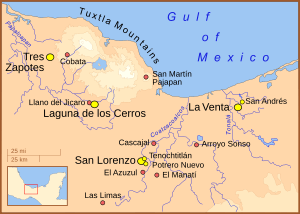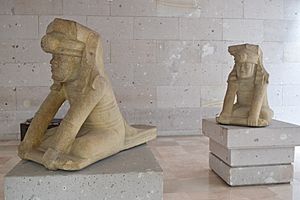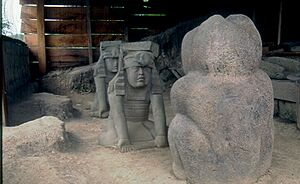El Azuzul facts for kids
El Azuzul is an ancient Olmec site in Veracruz, Mexico. It's an important place where archaeologists study the Olmec people. This site is very close to another big Olmec center called San Lorenzo Tenochtitlán. Experts believe El Azuzul was active around the same time, from about 1100 to 800 years before the Common Era (BCE). The site is named after the ranch where it was found. It sits on high ground near where two old rivers met, which were part of the Coatzacoalcos River system.
Contents
Incredible Olmec Sculptures
El Azuzul is famous for its amazing stone sculptures. These large statues are now on display at the Museo de Antropología de Xalapa in Xalapa, Mexico. They were found on the south side of a large pyramid-shaped hill at the site. The statues were still in their original spots, just as the Olmec people left them thousands of years ago. This was during a time called the Pre-Classic period in Mesoamerica.
The Mysterious Twin Statues
The most famous sculptures are two nearly identical human figures sitting down. These are often called the "twins." When they were found, the two statues were facing east, one behind the other. Some researchers think these "twins" might be early versions of the Maya Hero Twins. These heroes are important characters in the ancient Maya storybook, the Popul Vuh. However, because of the special hats they wear, others believe the statues might show important priests.
Each twin statue holds a ceremonial bar. Their right hand is under the bar, and their left hand is over it. It looks like they are lifting something very important. This object is sometimes called an axis mundi or a Mesoamerican world tree. This means it represents the center of the world or a connection between the sky, earth, and underworld.
The Powerful Jaguar Statues
Facing the two human statues was a large cat-like sculpture. This statue is usually identified as a jaguar. It is a little bigger than the human figures, standing about 1.2 meters (about 4 feet) tall. Another, even larger jaguar statue, about 1.6 meters (about 5.2 feet) tall, was found nearby. It seems that the jaguar statues were carved again from older monuments. This means the Olmec people might have reshaped them from earlier sculptures.
The human statues at El Azuzul are similar to other Olmec art. For example, the San Martin Pajapan Monument 1 also shows a young lord trying to lift a ceremonial bar. Even though this group of four statues hints at an old myth or story, we don't fully understand what it means. It's a mystery from the ancient Olmec world!
Buildings and Structures
Besides the large pyramid-shaped hill, the Olmec people also built a long pathway or wall along the river. This structure might have worked as a levee to control water or as a wharf for boats. El Azuzul also has other possible buildings that are now completely covered by plants and trees.
See also
 In Spanish: El Azuzul para niños
In Spanish: El Azuzul para niños




